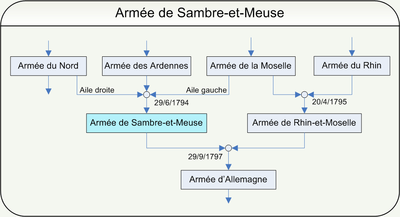Army of Sambre-et-Meuse

The Army of Sambre-et-Meuse (French: Armée de Sambre-et-Meuse) is the best known of the armies of the French Revolution. It was formed on 29 June 1794 by combining three forces: the Army of the Ardennes, the left wing of the Army of the Moselle, and the right wing of the Army of the North. It had a brief but celebrated existence. On 29 September 1797, the Army of Sambre-et-Meuse merged with the Army of the Rhine and Moselle to become the Army of Germany.
Battles
The various elements of the army won a key victory at the Battle of Fleurus on 16 June 1794. The merging of the forces into the Army of Sambre-et-Meuse was made official soon afterwards. Shortly after Fleurus, the Allied position in Flanders collapsed and the French armies overran both the Austrian Netherlands and the Dutch Republic in the winter of 1794-1795.
After the storming of Tournai and Ostend, the Convention declared that the army had merited honors. The Sambre-et-Meuse won more honors after the storming of Brussels, Maastricht, and Aix-la-Chapelle (Aachen). The army participated in the conquest of the Netherlands and the Siege of Luxembourg.
In 1795, the Sambre-et-Meuse fought on the middle Rhine. The army crossed the Rhine in 1796 to invade Germany but met defeat at the battles of Amberg and Würzburg during the summer. The army won a final victory over the Austrians at the Battle of Neuwied on 18 April 1797.
Commanders in Chief
- Jean-Baptiste Jourdan: 2 July 1794 – 23 September 1796
- Jacques Maurice Hatry: 21 December 1794 – 28 February 1795
- Jean-Baptiste Kléber: 22 January – 28 February 1796 and 31 July – 7 August 1796
- Pierre de Ruel, marquis de Beurnonville: 23 September 1796 – 23 January 1797
- Jean Etienne Vachier Championnet: 24 – 31 January 1797
- Jean Victor Marie Moreau: 1 – 25 February 1797
- Lazare Hoche: 26 February – 18 September 1797
- François Joseph Lefebvre: 31 July – 3 August 1797 and 19 September – 20 October 1797
References
 |
Le régiment de Sambre et Meuse
An 1870 French song about the Regiment (not the Army) of Sambre-et-Meuse by Robert Planquette and Paul Cézano. Sung by Pierre d'Assy. |
| Problems playing this file? See media help. | |